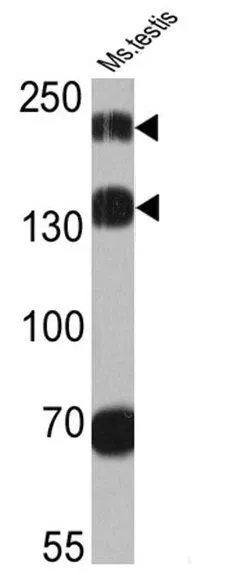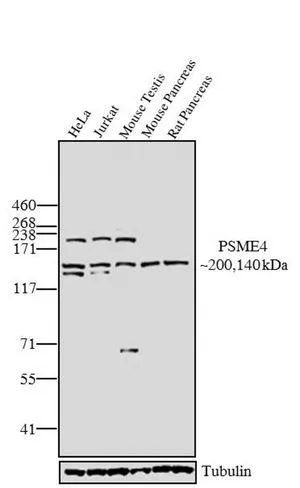
WB analysis of 25 ug of mouse testis cell lysates using GTX25620 Proteasome Activator Subunit 4 antibody. Dilution : 1:2000
Proteosome Activator, 200 kDa antibody
GTX25620
ApplicationsImmunoFluorescence, ImmunoPrecipitation, Western Blot, ImmunoCytoChemistry
Product group Antibodies
ReactivityBovine, Human, Mouse, Rat
TargetPSME4
Overview
- SupplierGeneTex
- Product NameProteosome Activator, 200 kDa antibody
- Delivery Days Customer9
- Application Supplier NoteWB: 1:250. ICC/IF: 1:600. *Optimal dilutions/concentrations should be determined by the researcher.Not tested in other applications.
- ApplicationsImmunoFluorescence, ImmunoPrecipitation, Western Blot, ImmunoCytoChemistry
- CertificationResearch Use Only
- ClonalityPolyclonal
- ConjugateUnconjugated
- Gene ID23198
- Target namePSME4
- Target descriptionproteasome activator subunit 4
- Target synonymsPA200; proteasome (prosome, macropain) activator subunit 4; proteasome activator 200 kDa; proteasome activator complex subunit 4; proteasome activator PA200
- HostRabbit
- IsotypeIgG
- Protein IDQ14997
- Protein NameProteasome activator complex subunit 4
- Scientific DescriptionProteolytic degradation is critical to the maintenance of appropriate levels of short-lived and regulatory proteins as important and diverse as those involved in cellular metabolism, heat shock and stress response, antigen presentation, modulation of cell surface receptors and ion channels, cell cycle regulation, transcription, and signalling factors. The ubiquitin-proteasome pathway deconstructs most proteins in the eukaryotic cell cytosol and nucleus. Other proteins are degraded via the vacuolar pathway which includes endosomes, lysosomes, and the endoplasmic reticulum. The 26S proteasome is an ATP-dependent, multisubunit (~31), barrel-shaped molecular machine with an apparent molecular weight of ~2.5 MDa. It consists of a 20S proteolytic core complex which is crowned at one or both ends by 19S regulatory subunit complexes. The 19S regulatory subunits recognize ubiquitinated proteins and play an essential role in unfolding and translocating targets into the lumen of the 20S subunit. The PA28/11S REG Activator protein complex functions as a proteolytic activator. PA200 has been identified as a 200 kDa nuclear protein that activates the 26S proteasome complex. Studies have shown that, in human tissues, PA200 mRNA levels are highest in testis, but is also present in liver, spleen, brain, heart, kidney and lung. Evidence suggests that this protein is involved in DNA repair, possibly by recruiting the proteasome to double-strand DNA breaks.
- ReactivityBovine, Human, Mouse, Rat
- Storage Instruction-20°C or -80°C,2°C to 8°C
- UNSPSC12352203

